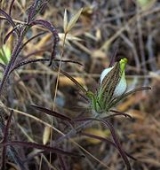
Cordylanthus rigidus
Encyclopedia
Cordylanthus rigidus is a species of flowering plant in the broomrape family
known by the common name stiffbranch bird's beak.
It is native to California
and northern Baja California
, where it grows in many types of habitat from coastal flats to high inland mountains. This is a hairy annual herb growing to maximum heights anywhere from 30 centimeters to 1.5 meters. There are at least four subspecies and possibly natural varieties not distinct enough to be considered subspecies. There is great variety in the appearance of the plant. The stem and foliage vary in color from greenish to yellows and reds; like other members of its family this species is a parasite
on other plants so it does not rely entirely on green chlorophyll
to produce its own nutrients. Its leaves are linear in shape and 1 to 4 centimeters long. The edges may roll in. The loose inflorescence
produces solitary flowers on long stalks. Each hair-covered flower is shaped like a conical bird's beak with leaflike, pointed outer and inner bract
s. Tucked inside is the pouched white flower. The whole unit is up to 2 centimeters long. The fruit is a capsule containing dark brown seeds one or two millimeters long.
Orobanchaceae
Orobanchaceae, the broomrape family, is a family of flowering plants of the order Lamiales, with about 90 genera and more than 2000 species. Many of these genera were formerly included in the family Scrophulariaceae sensu lato...
known by the common name stiffbranch bird's beak.
It is native to California
California
California is a state located on the West Coast of the United States. It is by far the most populous U.S. state, and the third-largest by land area...
and northern Baja California
Baja California
Baja California officially Estado Libre y Soberano de Baja California is one of the 31 states which, with the Federal District, comprise the 32 Federal Entities of Mexico. It is both the northernmost and westernmost state of Mexico. Before becoming a state in 1953, the area was known as the North...
, where it grows in many types of habitat from coastal flats to high inland mountains. This is a hairy annual herb growing to maximum heights anywhere from 30 centimeters to 1.5 meters. There are at least four subspecies and possibly natural varieties not distinct enough to be considered subspecies. There is great variety in the appearance of the plant. The stem and foliage vary in color from greenish to yellows and reds; like other members of its family this species is a parasite
Parasitic plant
A parasitic plant is one that derives some or all of its sustenance from another plant. About 4,100 species in approximately 19 families of flowering plants are known. Parasitic plants have a modified root, the haustorium, that penetrates the host plant and connects to the xylem, phloem, or...
on other plants so it does not rely entirely on green chlorophyll
Chlorophyll
Chlorophyll is a green pigment found in almost all plants, algae, and cyanobacteria. Its name is derived from the Greek words χλωρος, chloros and φύλλον, phyllon . Chlorophyll is an extremely important biomolecule, critical in photosynthesis, which allows plants to obtain energy from light...
to produce its own nutrients. Its leaves are linear in shape and 1 to 4 centimeters long. The edges may roll in. The loose inflorescence
Inflorescence
An inflorescence is a group or cluster of flowers arranged on a stem that is composed of a main branch or a complicated arrangement of branches. Strictly, it is the part of the shoot of seed plants where flowers are formed and which is accordingly modified...
produces solitary flowers on long stalks. Each hair-covered flower is shaped like a conical bird's beak with leaflike, pointed outer and inner bract
Bract
In botany, a bract is a modified or specialized leaf, especially one associated with a reproductive structure such as a flower, inflorescence axis, or cone scale. Bracts are often different from foliage leaves. They may be smaller, larger, or of a different color, shape, or texture...
s. Tucked inside is the pouched white flower. The whole unit is up to 2 centimeters long. The fruit is a capsule containing dark brown seeds one or two millimeters long.

